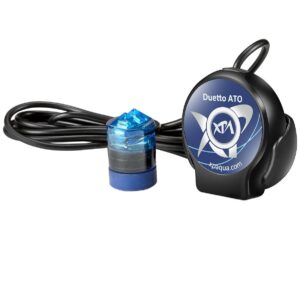Have you ever looked at your new Reef Casa tank and thought “are my eyes playing tricks on me? The water looks lower than it did a few days ago”? Well your eyes are not deceiving you, the water level in your tank is slightly lower due to evaporation. In this guide we will explain the impact of evaporation on your reef tank and some options for addressing this water loss.
Evaporation is an unavoidable stage in the water cycle (remember that thing you learned about in grade 9 science?) where water turns to vapor and returns to the atmosphere. In the oce
an this is counteracted by rainfall, which replaces evaporated water, but in a closed ecosystem like a reef tank human intervention is necessary. While it might be tempting to just add extra salt water during the weekly water change to bring water levels back up to normal this is a recipe for disaster. When evaporation occurs in a home aquarium the vapor is made up entirely of fresh water, leaving the dissolved salts behind in the tank. This means that evaporation will cause the salinity to increase as fresh water is removed. If a tank loses 5% of its water weekly to evaporation, by the end of the week the salinity will have increased from 35 ppt to just under 37 ppt. If the lost water is replaced with salt water during a water change the salinity will be almost 40ppt by the end of the second week, which will be detrimental to the health of any corals or fish in the tank.

The duetto ato is a super reliable and perfect for nano sized tanks
So what options exist to replace evaporated water without raising salinity? Essentially there are two choices for reefers, manually replacing evaporated water a few times a week with RO or RODI water, or using an auto top off. For hobbyists who choose to go the manual route all that is required is to make a small mark at the top of the waterline in an inconspicuous location on the tank and manually add water every few days so that the water level stays constant. This method is cheap and effective, but somewhat labour intensive. For this reason many reefers choose to invest in an auto top off, or ATO. These units consist of a small optical sensor, plastic tubing and a small pump. The optical sensor is placed in a rear chamber at the water level and when the water level drops below the sensor it triggers the pump, which will add fresh water to the tank. This helps to keep salinity much more stable than manually adding water, as well as allowing for more time to just sit back and enjoy your Reef Casa aquarium. Here are Reef Casa we recommend the Duetto Dual Sensor ATO system. This system has a backup optical sensor to prevent accidental overfilling. Regardless of what ATO system you choose, you will also need a reservoir to hold the freshwater that will be used to top up the tank. Any food grade plastic container will work, provided there is a hole large enough to insert the pump. While it may be tempting to buy a large container to reduce how often it needs refilled, a good rule of thumb is that the amount of water in the ATO reservoir shouldn’t be much larger than 10% of the total tank volume. In the highly unlikely event of a malfunction a smaller ATO reservoir will reduce the accompanying salinity drop, as well as reduce or prevent any tank overflow. A smaller reservoir also has the added benefit of being much easier to conceal.
Stability is key in reefing and since virtually all other parameters such as Alkalinity, Calcium and Magnesium are tied to salinity, an ATO is a simple way to help ensure the stability that corals need to thrive. If you have any questions about setting up your auto top off please send us an email and we will be happy to help. Happy reefing!

